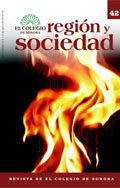 |
 |
 |
 |
 |
 |
 |
 |
 |
 |
 |
 |
Abstract
The implementation of a multidimensional strategy for sustainable forestry development in the cold temperate weather region in Chihuahua, Mexico was the objective of this study through the application of the Multi-Conference Search Model, based on the organization system of forestry producer associations (ejidatarios, comuneros, and small landowners, including indigenous and mestizo people).The participative methodology applied took into account the public nature of forest resource ownership in Mexico. Ejidos, communities, and other relevant actors were actively involved in this process. The multidimensional strategy designed incorporates the ecological, environmental, sociocultural, economic, political, institutional, scientific and technological dimensions, which include objectives and strategic actions that consider needs and common interests of the entities involved in the pursuit of sustainable regional forestry development.
References
Bray Barton, David, Leticia Merino–Pérez, Patricia Negreros–Castillo, Gerardo Segura–Warnholtz, Juan Manuel Torres–Rojo y Henricus R M. Vester. 2003. Mexico's Community–Managed Forests as a Global Model for Sustainable Landscapes. Conservation Biology 17 (3): 672–677.
Consejo Técnico Consultivo Forestal de Chihuahua. 1996. Programa Estatal de Desarrollo Sustentable Forestal. Resumen ejecutivo presentado al consejo en sesión del 15 de abril, Chihuahua.
Diario Oficial de la Federación. 2003. Ley General de Desarrollo Forestal Sustentable. 25 de febrero.
––––––––––. 2002. Programa Nacional Forestal 2001–2006. 27 de septiembre.
Emery Merrelyn y Ronald E. Purser. 1996. The Search Conference: A Powerful Method for Planning Organizational Change and Community Action. San Francisco: Jossey–Bass Publisher.
Fideicomiso Chihuahua Forestal. 2003. Ubicación de asociaciones de productores forestales en el estado de Chihuahua. Chihauhua.
Guerrero, María Teresa, Cyrus Reed y Brandon Vegter. 2000a. La industria forestal y los recursos naturales en la Sierra Madre de Chihuahua: impactos sociales, económicos y ecológicos. Chihuahua: Comisión de Solidaridad y Defensa de los Derechos Humanos, A.C. y Texas Center for Policy Studies.
Guerrero, María Teresa, Francisco Villa, Mary Kelly Cyrus Reed y Brandon Vegter. 2000b. La industria forestal en el estado de Chihuahua: impactos económicos, ecológicos y sociales después del TLCAN . Chihuahua: Comisión de Solidaridad y Defensa de los Derechos Humanos, A.C. y Texas Center for Policy Studies.
Luján Álvarez, Concepción, Jesús Miguel Olivas García, Salvador Balderrama Castañeda, Juan Manuel Chacón Sotelo, Juan Manuel Baca Venegas, Eduardo Arrieta Solís e Hilda Guadalupe González H. 2006. Desarrollo forestal sustentable en la cuenca del río Papigochi, estado de Chihuahua. Chihuahua: Universidad Autónoma de Chihuahua.
Luján Álvarez, Concepción. 2001. Protocolo para el diseño del plan estratégico participativo para el desarrollo forestal sustentable en Chihuahua. Delicias: Universidad Autónoma de Chihuahua.
Luján Álvarez, Concepción, Joel Diemer y Lois Stanford. 2000. Desarrollo de comunidades forestales en Chihuahua, México. Revista Madera y Bosques 6 (2): 29–39.
Secretaría de Agricultura y Recursos Hidráulicos. 1994. Inventario forestal periódico del estado de Chihuahua. México: Subsecretaría Forestal y de la Fauna Silvestre.
Secretaría de Medio Ambiente y Recursos Naturales–Comisión Nacional Forestal. 2001. Programa Estratégico Forestal para México 2025. México: SEMARNAT–CONAFOR.
Vanhanen, Heidi, Gerardo Mery, Sebastiao Kengen, Jussi Uusivuori, Susanna Laaksonen–Craig y Anne Toppinen. 2005. Responding to Increasing Social and Economic Demands on Forests. En Forests in the Global Balance–Changing Paradigms, editado por G. Mery, R. Alfaro, M. Kanninen y M. Lobovikov, 21–38. Helsinki: Unión Internacional de Organizaciones de Investigación Forestal (IUFRO, por sus siglas en inglés).
Open access policy
The authors who publish in región y sociedad accept the following conditions:
In accordance with the copyright laws, región y sociedad recognizes and respects the authors’ moral rights, as well as the ownership of property rights, which will be transferred to the journal to disseminate the articles in open access. región y sociedad does not charge the authors for submitting and processing articles for publication.
All the texts published by región y sociedad —with no exception— are distributed under a Creative Commons license 4.0 Attribution – Noncommercial (CC BY-NC 4.0 International), which allows third parties to use the publication as long as they mention the works’ authorship and the first publication in this journal.
The authors can enter into independent and additional contractual agreements for the nonexclusive distribution of the version of the article published in región y sociedad (for instance include it into an institutional repository or publish it in a book) as long as they clearly indicate that the work was published for the first time in región y sociedad.
For all the above, the author(s) must send the Letter of transfer of property rights of the first publication duly filled in and signed by the author(s). This letter can be sent by e-mail as a PDF to: region@colson.edu.mx






